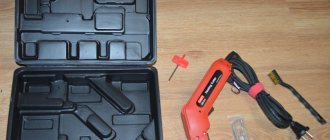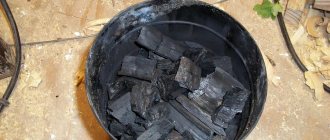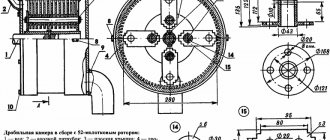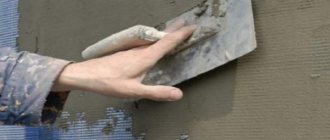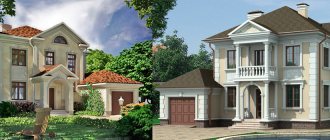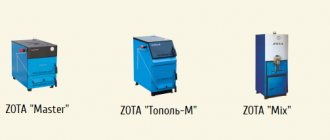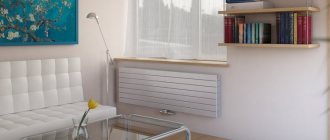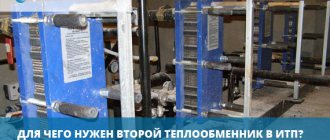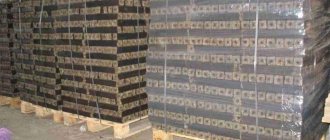On this page you will find ready-made sets of equipment for the production of block foam of all grades in accordance with GOST 15588-2014, for the production of sheet foam, for the production of permanent formwork, for the production of thermal panels, for foaming granules for furniture and for polystyrene concrete. To see the composition of the equipment - just click the required example. The sets of equipment differ in productivity, a set of additional equipment and the degree of automation. If none of the presented options suits you, you can write to us on request with the technical parameters of the required production. We will compile a set suitable for your tasks.
Lines for the production of block (sheet) foam.
How is expanded polystyrene made
Let's consider how the production of extruded polystyrene foam is made. The raw material is PSV or expandable polystyrene. Manufacturing proceeds as follows:
- PSV are foamed in a special chamber. From ordinary granules, they turn into balls, being pumped with gas. The process can take place several times - first the granule turns into a small ball, then it grows to the required size. Low density foams are made in a similar way. If foaming occurs once, then a material with a density of 12-15 kg / m3 is obtained. With double foaming - 10-12 kg / m3, with triple foaming - 8-10 kg / m3.
- Curing of foam balls. After foaming has occurred and the required diameter of the granules has been reached, they are transferred by air flow to the hopper, where they mature and dry at the required temperature and pressure. If foaming is carried out in 2-3 stages, then after each granules aging follows.
- Material formation. The balls, which have already taken their final shape and dried, are transferred to specialized equipment for the production of foam and processed with hot steam. At the same time, they slightly melt and expand, tightly sintering with each other and turning into a monolith.
- Excerpt. The monolithic block is placed in a room with a predetermined temperature and slowly cools down throughout the day. At the same time, excess moisture is removed from it and the material becomes solid. Handling a damp and warm block is not allowed, as it simply crumbles.
- Cutting. The blocks are fed to a specialized line, where they are cut to specified sizes.
- Packaging. Finished sheets are packed in plastic wrap and sent to the warehouse and store.
As you can see, there is nothing complicated in the production process - the line works in an automatic format and practically does not need human intervention. Employees provide only an auxiliary function, supplying raw materials, transporting semi-finished products and packaging them, which sharply reduces the percentage of rejects and possible technological errors.
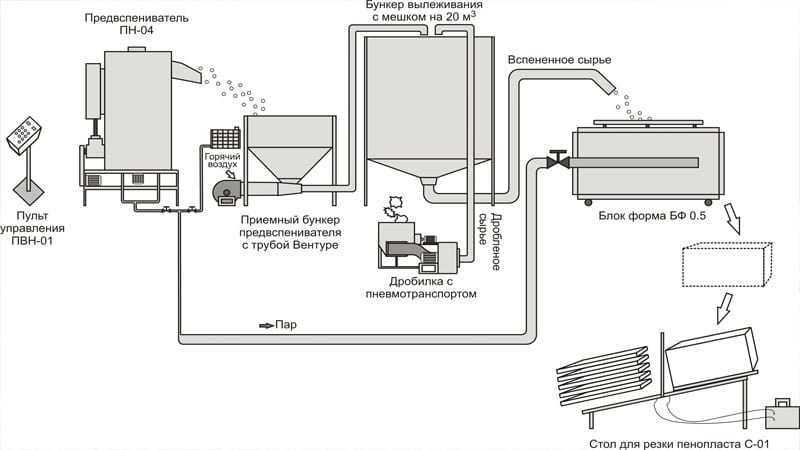
Selection of premises for production
The main requirements for the premises for placing the equipment are:
- Ceiling height 4.5 -5 meters
- The presence of an electric voltage of 380 W.
- Availability of water supply
- Sufficiency of space (to accommodate a set of equipment with a capacity of 20 cubic meters per shift, an area of 100 square meters is sufficient)
The business plan, first of all, should describe the choice of the premises in which the location of the foam plastic production is planned. There are special requirements for such a room.
First of all, they consist in the fact that the building for a mini-plant for the production of foam plastic must have at least 3 rooms, isolated from each other by fire-resistant shields.These premises include:
- Manufacturing facility. Its area must be at least 70 sq. meters, and the ceiling height is not lower than 5 meters. The room temperature should not drop below 10 degrees.
- Finished products warehouse. The minimum area for its placement is 50 sq. meters The warehouse can be located outside the building, however, for this it must be specially equipped with awnings and protective plates against adverse natural influences.
- A warehouse for raw materials with an area of about 10 sq. meters The temperature in the room should not exceed 20 degrees.
The production room must have a continuous supply of electricity and the water supply system must function properly.
Market research
In addition to the technical characteristics of the production building itself, you should consider the geographical location of the future mini-plant. To do this, you should first study the structure of the market in this area, consider those regions in which there is a demand unredeemed by supply for foam products. Such regions are most favorable for planning the launch of a new commercial project there.
In addition, in the business plan for the opening of industrial production of foam plastic, the future ways of marketing the products must be clearly formed and indicated. Also, in the project of opening a foam plastic production, when calculating the main economic indicators, some seasonality of the business should be taken into account.
The production must have a warehouse of finished products
Required equipment for extruded PPP
Extruder - equipment for the production of extruded foam. It has forming dies through which the polystyrene melt is pushed.
Manufacturing technology provides for a different approach to foaming raw materials. In this case, the granules are mixed with a foaming agent in a nitrogen atmosphere.
It is difficult to recommend certain brands of equipment for the production of foam, all purely individual. Basically, it all depends on the financial capabilities and the expected production volumes. We recommend looking at existing manufacturers of building materials and conducting competitive intelligence.
30.01.2020
Production plan
The production activity begins with a thorough study of the technology. High-quality and suitable premises for work are selected, as well as modern and multifunctional equipment is purchased. Permanent distribution channels are developed in advance.
Foam production is carried out using special polystyrene granules. Their size does not exceed 0.35 cm, and in appearance they resemble translucent beads. The process of obtaining polystyrene itself is divided into stages:
- the granules are foamed by the action of steam, as a result of which they significantly increase in size;
- enlarged elements go through a drying procedure in a special apparatus, where moisture evaporates from them;
- the resulting raw material is aged for about 10 hours, and this time may be different depending on what brand of foam is being created;
- raw materials are laid in special forms, in which they are heated at high temperature and pressure for about 10 minutes;
- the resulting plates are cooled;
- blocks are lined up in a warehouse, where they are located for about a month, during which moisture is completely removed from them;
- the slabs are cut into standard size elements using a string cutting machine.
Thus, the production process is considered to be quite simple and straightforward. During operation, it is allowed to use waste from other industries where foam is used, which will save on raw materials.
Production personnel
A promising direction for the use of polystyrene is the manufacture of packaging
Do not assume that due to the acquisition of modern high-quality equipment, personnel for future production will not be needed.To ensure the direct production process and equipment maintenance, workers and a technologist must be hired.
It is best to recruit workers on the basis of production work in 2 shifts. For the work of 1 shift, four workers and 1 technologist must be involved. Accordingly, a total of 8 workers and 1 technologist should be hired.
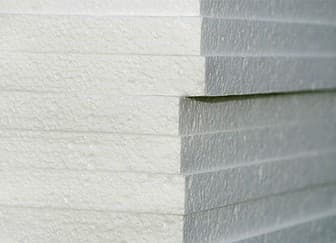

In addition, an employee should be hired to clean the premises, and an accountant (albeit coming) should be involved to resolve issues of accounting, reporting and taxation.
In addition to the list of employees, the business plan "Production of foam plastic" should also indicate its approximate salary.
Financial plan
The result of drawing up a business plan for the production of foam (and its most valuable information from the point of view of investors) is the calculation of finances.
These indicators include:
- Purchase of equipment - approximately 850,000 - 900,000 rubles.
- The monthly salary of workers and technologist is at least 96,000 - 100,000 rubles.
- Other expenses related to utility bills, unforeseen circumstances, equipment repairs and others.
If we take into account the fact that the production of polystyrene will take place 5 days a week and in two shifts, and stable ways of selling finished products in bulk will be established, then the payback period for such a business will be no more than 3-5 months.
In total, the size of the start-up capital for the foam production will be approximately 960,000 - 1,000,000, but this applies to the purchase of equipment and production raw materials. If the lease of premises or its purchase is additionally required, then the amount of the initial capital will increase significantly.
Additional costs will entail holding an advertising campaign and production of outdoor advertising means.
Industry analysis
Without studying competitors, buyers and other market participants, it is impossible to open any successful company, therefore, marketing research is carried out beforehand.
Market analysis
Before starting a business, the features of the selected market segment are studied, which contributes to obtaining information:
- the potential of using foam in various fields of activity is assessed;
- the main competitors, as well as their buyers and suppliers are determined;
- the relevance of opening a new organization specializing in the production of foam plastic is analyzed, since in some regions, due to high competition, the niche is considered oversaturated;
- the strengths of the new company are thought out and developed, which are the basis for gaining a significant market share.
Important! The analysis can be carried out independently with the appropriate knowledge and skills, and you can also contact specialized consulting companies.

